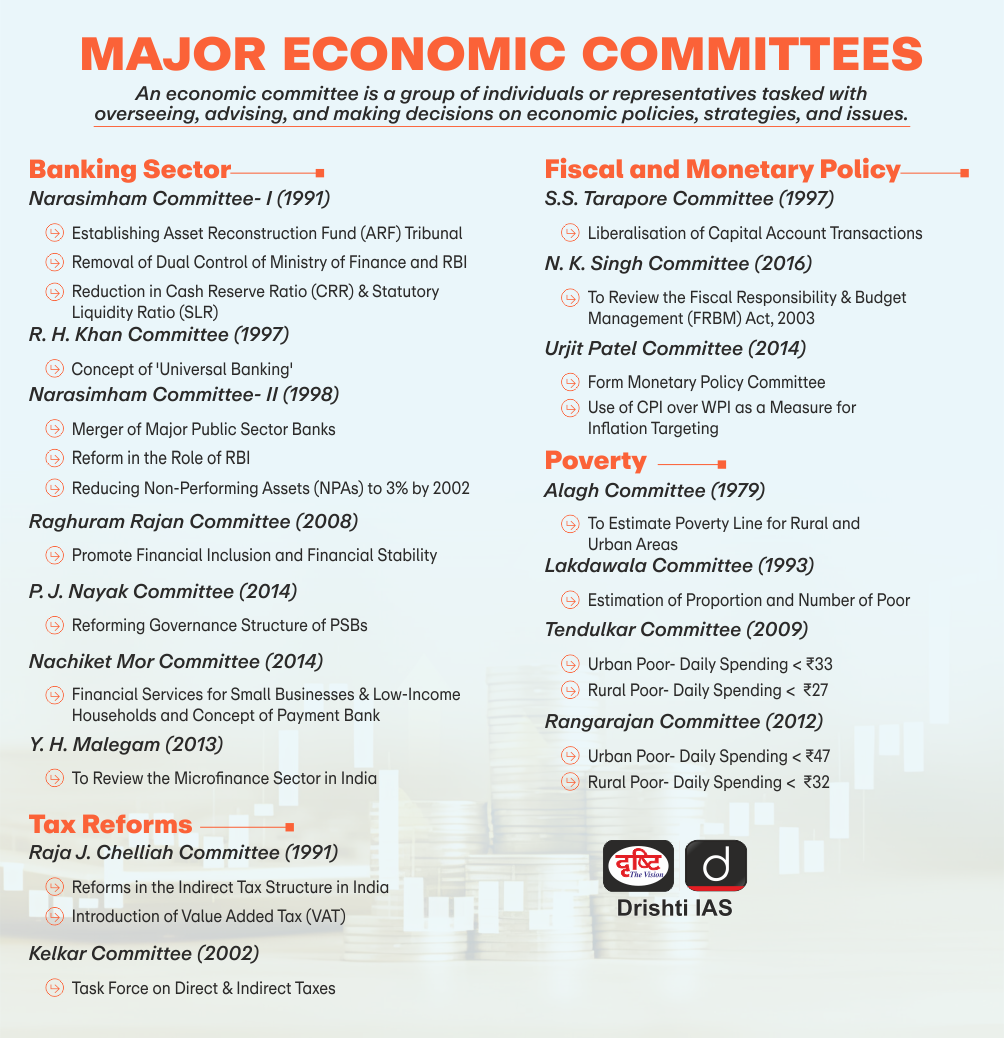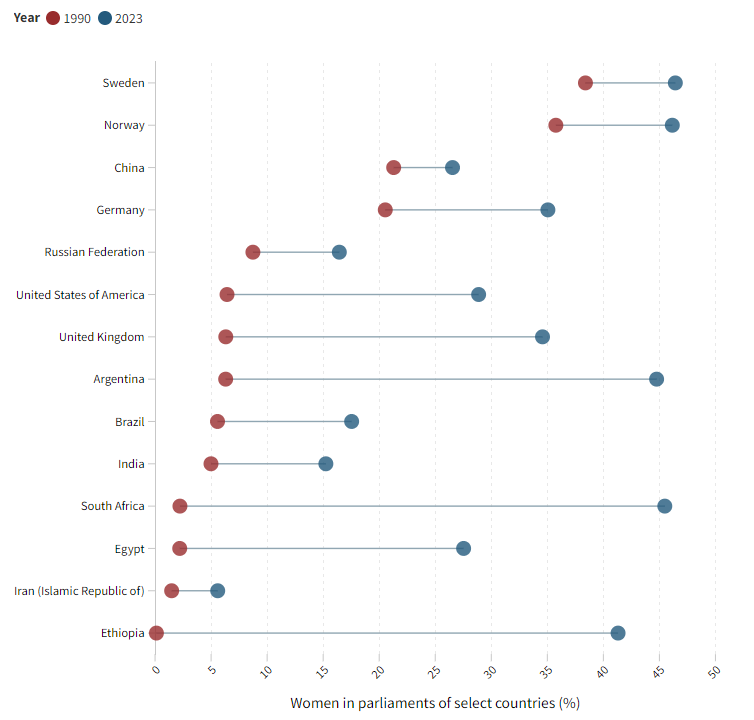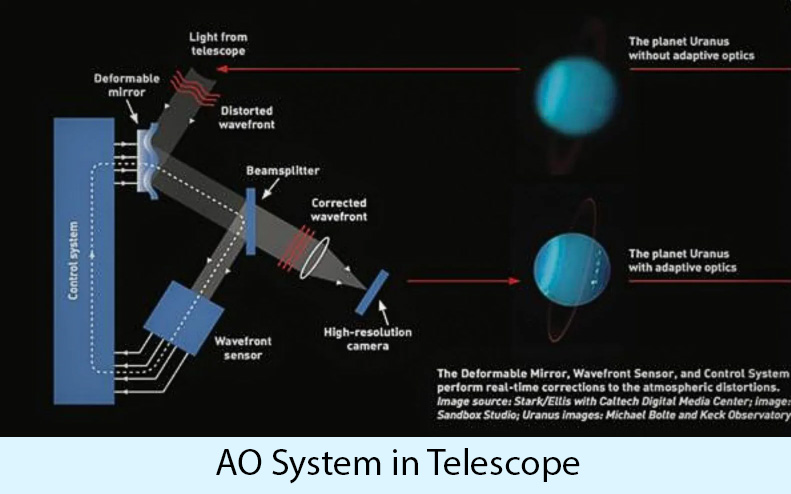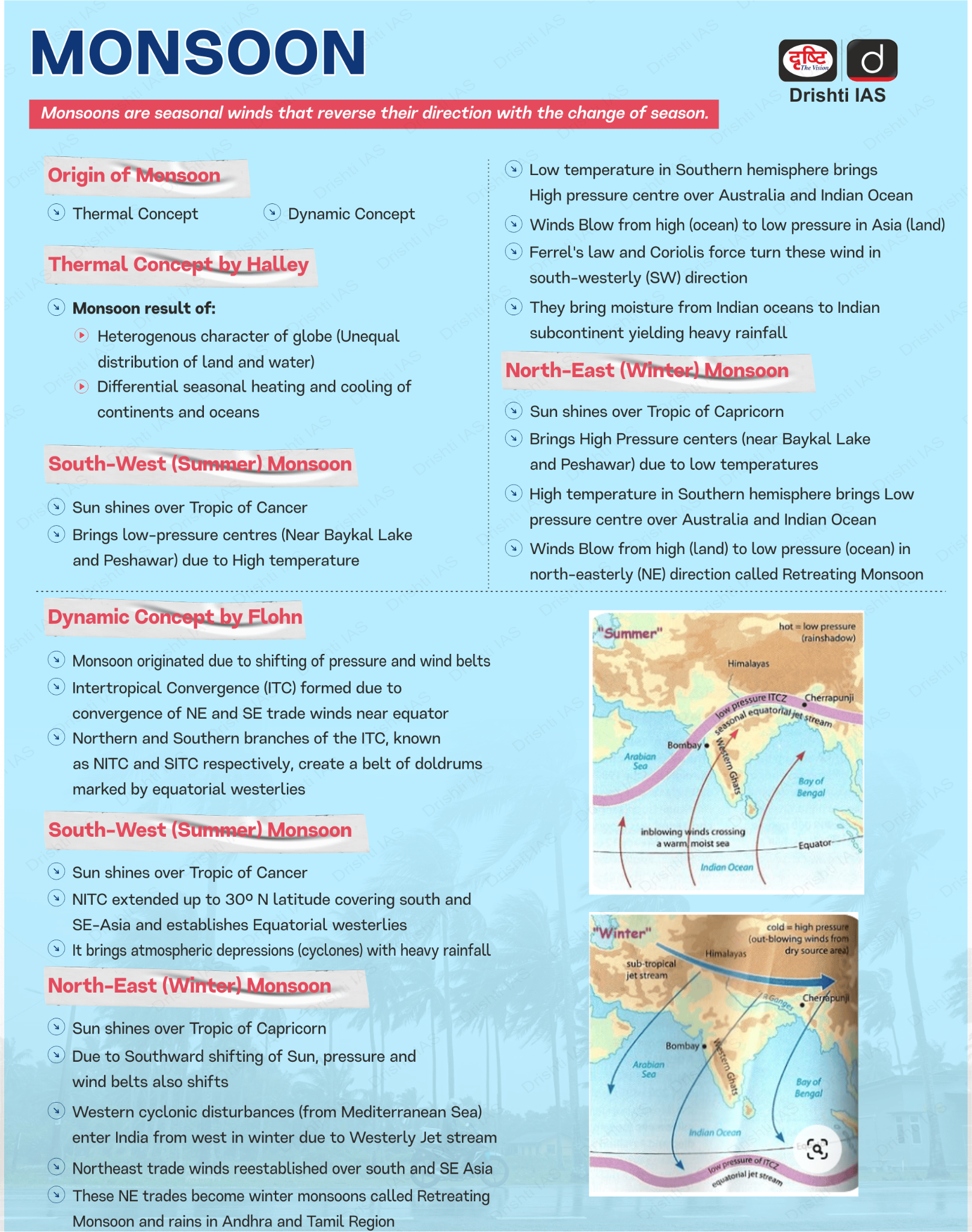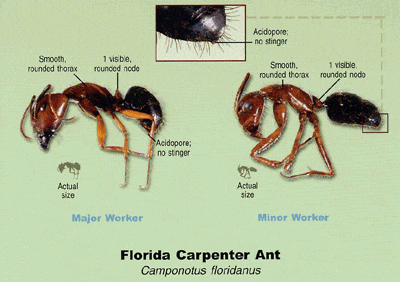DPDP Act 2023 and the Issue of Parental Consent
For Prelims: Digital Personal Data Protection Act, National Data Governance Policy,, Data fiduciaries, Data Protection Board of India, Right to privacy
For Mains: Data privacy, Data Protection Act 2023, Challenges and Way Forward
Why in News?
Recently, while the industry has largely welcomed the Digital Personal Data Protection Act (DPDPA) 2023 for its straightforward compliance structure, the provision requiring verifiable parental consent before processing children’s data has sparked division between industry and government.
What are the Salient Features of the Digital Personal Data Protection Act (DPDPA) 2023?
- Right to Data Protection: It empowers individuals with the right to know and control their personal data. This includes rights to access, correction, and erasure of their data, giving citizens greater control over their personal information.
- Data Processing and Consent: The Act mandates that personal data can only be processed with the explicit consent of the individual. Organisations must provide clear and specific consent forms and ensure that consent is obtained before data collection.
- Data Localisation: Certain types of sensitive personal data are required to be stored and processed within India. This provision aims to enhance data security and facilitate easier enforcement of data protection laws.
- Regulatory Authority: The Act establishes a Data Protection Board of India (DPBI) to oversee compliance and handle grievances. The Board is responsible for adjudicating disputes and imposing penalties for violations.
- Data Breach Notification: Organisations are required to notify individuals and the Data Protection Board of any data breaches that may compromise personal information. This provision aims to ensure transparency and prompt action in the event of data leaks.
- Fines and Penalties: It outlines stringent penalties for non-compliance, including significant fines for violations. This is intended to incentivize organisations to adhere to data protection standards.
What are the Issues with Obtaining the Parental Consent?
- About:
- Under Section 9 of the DPDP, 2023 data fiduciaries must obtain verifiable consent from parents or guardians before processing children’s data.
- The Act also bans harmful data processing and ad targeting for minors.
- However, some entities can be exempted from obtaining verifiable parental consent and age gating requirements including healthcare and educational institutions.
- Also, some entities can be exempted from the norms on a restricted basis, that is, depending on the specific purpose for which they need to process a child’s data.
- Under Section 9 of the DPDP, 2023 data fiduciaries must obtain verifiable consent from parents or guardians before processing children’s data.
- Issues:
- While the act introduces measures for child data protection, including parental consent, challenges remain regarding age verification and defining what constitutes harm to children.
- Handling situations where parents revoke consent or children reach the age of consent requires careful management.
- Issues like storing biometric data, and ensuring compatibility across various devices can pose difficulties in implementation.
- The act itself does not suggest ways in which platforms can perform age-gating leading to a major sticking point for the industry.
- Another challenge is how the relationship between a child and his/her parents can be reliably established.
- The inability to arrive at a conclusive decision on how to proceed with the verifiable parental consent provision is the biggest reason behind the delay in releasing the data protection rules without which the act cannot be operationalised (the DPDP Act depends on at least 25 such provisions to implement the modalities of the Act).
- Likely Solution and Their Limitations:
- Initially, the MeitY considered using parents’ DigiLocker app, which relies on Aadhaar details. However, scalability and privacy concerns led to its dismissal.
- Another option was for the industry to create an electronic token system, authorised by the government. However, this approach also faced practical limitations.
- In a recent meeting between the MeitY and the Industry representatives, the latter suggested a graded approach based on risk, citing the UK’s Age Appropriate Design Code (AADC) as a model.
Note: Global Practices on Parental Consent:
- Globally, privacy legislations have not prescribed a technology to gather verifiable parental consent, and have left it to data collectors to use relevant technology through which such consent can be gathered.
- E.g., the US Children's Online Privacy Protection Act (COPPA) doesn't specify the exact method for obtaining parental consent but requires using a method that is "reasonably designed" given the available technology to confirm the identity of the child's parent.
- The European Union’s General Data Protection Regulation (GDPR) requires data collectors to make “reasonable efforts” using available technology to verify that consent provided on behalf of a child under the age of 13 has, in fact, been provided by the holder of parental responsibility for that child.
What are the Possible Suggestions for Addressing the Issue of Parental Consent?
- Self-Declaration: Companies can allow parents to declare their relationship with the child during account setup. However, this relies on honesty and lacks robust verification.
- Two-Factor Authentication (2FA): Implementing 2FA for parental accounts can enhance security. Parents receive a code via SMS or email to confirm consent.
- Biometric Verification: Leveraging biometrics (such as fingerprint or facial recognition) for parental consent can be secure and privacy-friendly.
- Proxy Consent: Parents could authorise a trusted third party (like a school or paediatrician) to verify their relationship with the child.
|
Drishti Mains Question: Q. Discuss the challenges and potential solutions in the effective implementation of the Digital Personal Data Protection Act (DPDPA), 2023. |
UPSC Civil Services Examination, Previous Year Question (PYQ)
Prelims:
Q1. ‘Right to Privacy’ is protected under which Article of the Constitution of India? (2021)
(a) Article 15
(b) Article 19
(c) Article 21
(d) Article 29
Ans: (c)
Q2. Right to Privacy is protected as an intrinsic part of Right to Life and Personal Liberty. Which of the following in the Constitution of India correctly and appropriately imply the above statement? (2018)
(a) Article 14 and the provisions under the 42nd Amendment to the Constitution.
(b) Article 17 and the Directive Principles of State Policy in Part IV.
(c) Article 21 and the freedoms guaranteed in Part III.
(d) Article 24 and the provisions under the 44th Amendment to the Constitution.
Ans: (c)
Mains:
Q. Examine the scope of Fundamental Rights in the light of the latest judgement of the Supreme Court on Right to Privacy. (2017)
Political Representation of Women
For Prelims: General Elections, Election Commission of India, Delimitation Commission, Political Parties, Reservation.
For Mains: Issue and Reasons for Low Representation of Women in Parliament, Issues Related to Women, Women's Issues, Inclusive Growth, Human Resource, Government Policies & Interventions, Women’s Reservation Act, 2023
Why in News?
The recently concluded general elections in the United Kingdom have seen a record 40% women representation in the House of Commons, highlighting the significant progress made by other countries in enhancing women's political participation.
- In contrast, India's women's representation in the Parliament remains well below the global average of 25%.
What is the Status of Women’s Representation in Indian Parliament?
- Women’s Representation in Parliament: In the Lok Sabha, the percentage of women members has risen from 5-10% until 2004 to 13.6% in the current 18th Lok Sabha, while in the Rajya Sabha, it is 13%.
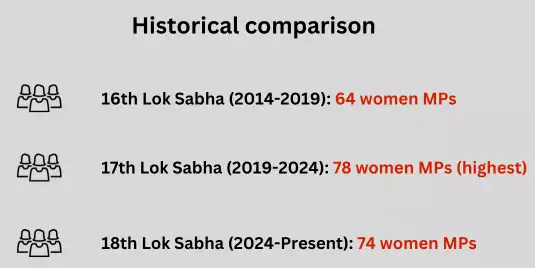
- Also, the number of women contesting elections has shown a gradual increase over the past 15 years.
- In 1957, just 45 women candidates were contesting the Lok Sabha election; in 2024 there were 799 (9.5% of the total candidates contested).
- West Bengal leads in electing the most women MPs, with 11 representatives. The Trinamool Congress has the highest proportion of women among its Lok Sabha MPs, at 38% in the 18th Lok Sabha.
- This is far below the global average of around 25%.
- Also, the number of women contesting elections has shown a gradual increase over the past 15 years.
- Women’s Representation in State Legislatures: The national average of women's representation in State Legislative Assemblies stands at a mere 9%, with no state having more than 20% women legislators.
-
Even Chhattisgarh, the state with the highest representation, has only 18% women MLAs.
-
-
Global Scenario: India ranks 143 out of 185 countries in terms of women's representation in the lower house of Parliament.
- Sweden has 46% female MPs, South Africa (45%), the UK (40%) and the US (29%).
- India lags behind countries like Vietnam, the Philippines, Pakistan, and China in gender representation.
What are the Reasons for the Underrepresentation of Women in Politics?
- Socio-Cultural Barriers: Patriarchal norms and gender stereotypes limit women's participation in politics. Household responsibilities and lack of family support, along with disparities in education and economic empowerment, especially in rural areas contributes to such barriers.
- Political Party Dynamics: Male-dominated parties often hesitate to field women candidates, relegating them to "safe" or "unwinnable" seats. The lack of internal quotas or affirmative action policies further hinders women's candidacy.
- Electoral System Challenges: The first-past-the-post system favours established male candidates with strong financial and organisational backing. High election costs and the prevalence of criminalisation and money power in politics further disadvantage women.
- Institutional and Legal Barriers: The delayed implementation of the 73rd and 74th constitutional amendments, which provide for one-third reservation for women in local bodies, has limited the pipeline of women entering politics.
- The repeated failure to pass the Women's Reservation Bill, which proposed 33% reservation for women in Parliament and state legislatures, is another major institutional barrier.
- Lack of Political Will: Insufficient prioritisation of women's political empowerment by major parties and lack of sustained pressure from women's movements and civil society perpetuate the status quo.
What are the Arguments in Favour of Women's Reservation in Indian Parliament?
- Enhancing Women's Political Representation: Currently, women's representation in Parliament is far below the global average of around 25%. A 33% reservation would help bridge this gap and ensure a more equitable representation of women in the Indian Parliament.
-
Promoting Gender Equality and Inclusive Governance: Women in India face socio-cultural, economic, and political barriers to political participation, including patriarchal norms, lack of resources, and gender-based violence.
- Also, they make up nearly 50% of India's population but are underrepresented in political decision-making. Increasing their representation would lead to more gender-sensitive policies and better address the unique challenges women face.
- Strengthening Democratic Participation: Reserving one-third of seats for women would empower their active participation in politics, strengthen inclusive democracy and will initiate more women and children-centric policies that will help in human development.
- For instance, in many villages, women representatives have played a crucial role in eradicating child marriage, improving maternal health, and ensuring access to clean drinking water.
What Measures Have Been Taken to Address the Underrepresentation of Women in Indian Politics?
- Constitutional Amendments:
-
The 73rd and 74th Constitutional Amendments (1992/1993) provided for one-third reservation of seats for women in Panchayats and Municipalities, increasing their participation in local governance.
- The 106th Constitutional Amendment (2023) proposes a one-third reservation of seats for women in the Lok Sabha and state legislative assemblies, though its implementation is contingent on the next delimitation exercise.
- The reservation will be implemented after the first census following the commencement of the 106th Amendment Act including a delimitation exercise.
-
- The Women's Reservation Bill:
- The bill, first introduced in 1996, proposed 33% reservation for women in the Lok Sabha and state legislative assemblies. Despite several attempts, the bill has not been passed due to a lack of political consensus among major parties.
- Voluntary Party Quotas: Several political parties in India have female representation in their candidates for elections.
- The Naam Tamilar Katchi stands out with 50% women candidates, followed by Lok Janshakti Party and Nationalist Congress Party with 40% each.
- Jharkhand Mukti Morcha, Biju Janata Dal, and Rashtriya Janata Dal had 33%, 33%, and 29% female representation, respectively.
- Meanwhile, the Samajwadi Party had 20% and All India Trinamool Congress had 25% women candidates.
- Empowerment Schemes and Programs:
- Initiatives like the Mahila Shakti Kendra, Beti Bachao Beti Padhao, and STEP have aimed to improve women's socio-economic status, but have had limited direct impact on enhancing their political participation.
- Civil Society and Women's Movements:
- There has been sustained advocacy by women's rights groups, activists, and organisations for greater political representation.
|
Drishti Mains Question: What are the major challenges hindering women's representation in politics in India and what measures can be taken to overcome them? |
UPSC Civil Services Examination Previous Year Question
Q.1 What are the continued challenges for Women in India against time and space? (2019)
Q.2 Discuss the desirability of greater representation to women in the higher judiciary to ensure diversity, equity and inclusiveness. (2021)
India Needs an Internal Security Plan
For Prelims: Article 355, Central Bureau of Investigation , National Security Advisory Board, Central Armed Police Forces, Article 370, Indian Coast Guard, National Investigation Agency
For Mains: Internal security framework, Major Security Challenges Confronting India.
Why in News?
As India solidifies its international position and strengthens its economy, the necessity for a comprehensive internal security plan becomes increasingly apparent. Recent developments highlight the need of addressing internal security challenges to maintain national cohesion and stability.
What is the Need and Way Forward for an Internal Security Plan for India?
- National Security Doctrine (NSD): The country should have a NSD to address internal and external challenges. The National Security Advisory Board has worked on drafts, but they were never approved.
-
It is important to have a consistent approach to internal security, especially during changes in government.
- It will guide policy decisions and strategic actions, reducing ad-hoc responses and improving coherence in handling security issues.
-
- Internal Security Ministry: The Ministry of Home Affairs is too heavy and unwieldy, leading to delayed and inadequate attention to internal security matters. It is time to appoint a young, junior minister to independently handle internal security.
- According to Article 355 in Constitution of India, the Union is responsible for protecting every State from external aggression and internal disturbance, and for ensuring that each State's government operates in accordance with the Constitution.
- Recent Issues in Jammu and Kashmir: The Home Minister claims terror incidents are down by 66% since the abrogation of Article 370, but recent attacks in Jammu show the situation is far from normal.
-
The government needs to reorganise the security grid, restore statehood to J&K, and hold elections for the Assembly to address the objectives of the Pakistani deep state.
-
-
Stabilizing the Northeast Region: The Prime Minister has described the Northeast as "a piece of our heart", but the region continues to face challenges.
-
The 2015 Framework Agreement with the rebel Nagas has not been fully realized due to the National Socialist Council of Nagaland - Isak-Muivah's (NSCN-IM) demand for a separate flag and constitution.
-
The government needs to ensure strict implementation of the ceasefire agreement and prevent rebel activities like extortion and forcible recruitment.
-
Manipur is still struggling with ethnic conflicts and occasional violence, despite the formation of a multi-ethnic peace committee by the Home Ministry.
-
It's time for the Prime Minister to personally address these issues.
-
-
Additionally, addressing problems like illegal migration, drug trafficking, and arms smuggling would require a comprehensive approach.
-
-
Naxal Problem: The Minister of State for Home Affairs reported in the Rajya Sabha that the "national policy and action plan" has led to a significant decrease in left-wing extremism (LWE) violence and its geographical influence.
-
Violence and deaths have decreased by 73% since 2010, and the number of police stations reporting LWE-related violence has also decreased.
-
With Naxals on the backfoot, it is time for the government to offer them a unilateral cease-fire, persuade them to negotiate, address their grievances, and try to integrate them into mainstream society.
- Strategies to combat Naxalism include security measures, development projects, and welfare initiatives, leading to a decline in related incidents.
-
-
Intelligence and Investigation Agencies: The Intelligence Bureau and the Central Bureau of Investigation (CBI) need restructuring. The IB was set up through an administrative order in 1887. It is high time that it is given a statutory basis to prevent misuse of intelligence for political gain.
-
The CBI was set up through a resolution in 1963, and it derives the power to investigate from the Delhi Special Police Establishment Act, 1946.
-
It is an anomalous arrangement and, as recommended in the 24th report of the parliamentary committee, “the need of the hour is to strengthen the CBI in terms of legal mandate, infrastructure and resources”.
-
-
-
Reforming State Police Forces: Legacy issues from colonial policing models and insufficient focus on community needs.
- Transform state police from "Ruler's Police" to "People’s Police" to enhance public trust and effectiveness.
- Adopting best practices from global reforms can modernize and improve policing standards.
- Central Armed Police Forces: The Central Armed Police Forces (CAPFs), with over a million personnel, face internal issues such as unplanned expansion, haphazard deployment, inadequate training, declining discipline standards, vague criteria for top officer selection, and friction between cadre and All India Service officers.
-
The government should appoint a high-powered commission to address these problems for long-term solutions.
-
-
Technology: The police in the country can benefit greatly from incorporating technological advancements. Setting up a high-powered technology mission to recommend the latest technologies for addressing current and future challenges is crucial.
-
By enhancing internal cohesion and addressing security issues, the country can project its strength internationally.
-
What Measures Has the State Taken to Address Internal Security Challenges?
- Counterterrorism Efforts: Post the 2008 Mumbai attacks, there has been a significant focus on counterterrorism, including the abolition of Article 370 and strategic operations in Jammu and Kashmir.
- Maritime security, especially coastal security, has seen significant improvements since the Mumbai attacks. Efforts include strengthening coastal security and maritime surveillance, improving the capabilities of the Indian Coast Guard, and enhancing interstate coordination.
- Northeast Insurgency Management: Through a combination of development and diplomacy, the government has worked to control insurgency in the Northeast.
- Dealing with Left-Wing Extremism: Enhanced strategies and coordination have improved the handling of Naxalism and related activities.
- The CAPFs have been equipped to handle extremism more effectively, resulting in positive outcomes.
- Border Management: Significant resources have been invested in improving border security, including fencing and development in border regions
- Efforts are made not only to secure borders but also to improve development and connectivity in border regions. Special attention is given to managing borders prone to drug and arms smuggling, particularly with China and Pakistan.
- Institutional Framework Support: Institutions involved in internal security, such as police forces and CAPFs, have received enhanced resources, technology, and training. There is a heightened focus on emerging threats, including cybercrime, preventing atrocities against women, and addressing new-age crimes.
-
The Ministry of Home Affairs, with a budget of nearly Rs 200,000 crore for 2023-24, plays a key role as the nodal agency for internal security, overseeing about one million CAPF personnel and supporting national security efforts through state police forces.
-
What are the Key Acts and Institutions Involved in Internal Security?
- Legislative Framework: Key acts include the Code of Criminal Procedure Act(1973), Unlawful Activities (Prevention) Act (1967), National Security Act (1980), Prevention of Money Laundering Act (PMLA) (2002) and various other laws aimed at addressing security challenges.
- Institutions and Agencies:
-
Ministry of Home Affairs: The central agency responsible for internal security, with a substantial budget and numerous departments.
-
National Investigation Agency (NIA): Established under the National Investigation Agency Act of 2008. It is the primary federal agency for investigating terrorism and related crimes in India.
- Handles cases involving terrorism with cross-state connections, illicit trafficking, and other severe offences.
- The National Investigation Agency (Amendment) Act 2019 expanded its jurisdiction to include human trafficking, counterfeit currency, prohibited arms, explosive substances, and cyber-terrorism.
- Intelligence Bureau: It was established by the British in the 19th century, the Director of Intelligence Bureau (DIB) is typically the most senior police officer in the country and has direct access to the Minister of Home Affairs, the Prime Minister, and the National Security Advisor.
- Multi-Agency Centre (MAC): It has been strengthened by the Ministry of Home Affairs (MHA) to operate 24x7 for collecting and sharing security-related information.
- National Intelligence Grid: NATGRID is an IT platform created to aid security and law enforcement agencies in countering terrorism for national security.
-
It links various databases such as railways, police, stolen vehicles, immigration, airlines, passports, vehicle ownership, driving licences, PAN data, and more to monitor terror activities and serve national security interests.
-
-
Combating Financing of Terrorism(CFT) Cell: The MHA's CFT Cell handles policy matters on combating financing of terrorism and fake Indian currency notes.
- States have raised Special Forces, Anti-Terrorism Squad (ATS) to deal with terrorism incidents, and also Central Armed Police Forces (CAPFs) & National Security Guards (NSG) have been stationed at various locations to assist the States.
-
Conclusion
To address internal security challenges effectively, India must adopt a unified National Security Doctrine, streamline its security institutions, and integrate advanced technologies. Strengthening regional stability and modernising law enforcement will ensure a comprehensive and adaptive response to emerging threats. Enhanced coordination and strategic planning are essential for a secure and resilient nation.
Read More: Office of NSA & India’s National Security Framework
|
Drishti Mains Question: Q. Assess the current status of India's internal security framework. What are the major challenges that need to be addressed for effective internal security management? |
UPSC Civil Services Examination, Previous Year Questions (PYQs)
Mains
Q. What are India’s internal security challenges? Give out the role of Central Intelligence and Investigative Agencies tasked to counter such threats. (2023)
Q. Analyze the multidimensional challenges external state and non-state actors pose to India’s internal security. Also, discuss measures required to be taken to combat the threats. (2021)
Q. What are the sound determinants of left-wing extremism in the Eastern part of India? What strategy should the Government of India, civil administration, and security forces adopt to counter the threat in the affected areas? (2020)
SEBI Proposes a New Asset Class
Why in News?
The Securities and Exchange Board of India (SEBI) has proposed the introduction of a new asset class or product category.
- This move is aimed at providing investors with a regulated investment product that features higher risk-taking capabilities, while also curbing the proliferation of unregistered and unauthorised investment products.
Note:
- PMS allows investors to rely on professionals to manage their investment portfolio and earn competitive returns from various asset classes.
- The service is tailored to meet the specific needs of each investor, ensuring that it meets their expectations and requirements.
What is the Proposed New Asset Class?
- Minimum Investment Threshold: The minimum investment threshold under the new asset class has been proposed at Rs 10 lakh per investor.
- Distinct Nomenclature: SEBI proposes distinct naming for this new asset class to differentiate it from traditional MFs, PMS, Alternative Investment Funds (AIFs), Real Estate Investment Trusts (REITs), and Infrastructure Investment Trusts (INVITs).
- Investment Strategies: Some of the investment strategies that may be permitted include long-short equity funds and inverse ETF (exchange-traded fund) (funds that are traded on stock exchanges, much like individual stocks).
- Investors may also have an option of systematic plans such as systematic investment plan (SIP), systematic withdrawal plan (SWP) and systematic transfer plan (STP) for investment strategies under the new asset class.
- Eligibility Criteria for Asset Management Companies (AMCs):
-
Two Routes of Eligibility:
-
First Route: Existing MFs operational for at least three years with an average asset under management (AUM) of Rs 10,000 crore and No action initiated by SEBI against the sponsor/AMC in the last 3 years can directly offer products in this new class.
-
Second Route: Existing and new MFs that do not fulfil the first eligibility route should appoint a Chief Investment Officer (CIO) with at least 10 years of fund management experience and managing AUM of not less than Rs 5,000 crore.
-
Appointment of an additional fund manager with at least 7 years of fund management experience and managing AUM of not less than Rs 3,000 crore.
-
-
-
-
Potential Benefits and Implications:
- Regulated investment product: The new asset class is expected to provide investors with a regulated investment product that offers higher risk-taking capabilities and a higher ticket size.
- Bridging the gap between MFs and PMS: The new asset class is intended to fill the gap between MFs and PMS, offering a product that caters to the needs of the emerging category of investors.
- Strengthening the role of MFs: The eligibility criteria for offering products under the new asset class may strengthen the position of established MFs and AMCs in the investment landscape.
Securities and Exchange Board of India (SEBI)
SEBI is a Statutory Body established in 1992 in accordance with the provisions of the Securities and Exchange Board of India Act, 1992 to protect investors' interests and regulate the securities market.
- Its headquarters is in Mumbai, with regional offices in Ahmedabad, Kolkata, Chennai, and Delhi.
- Before SEBI's establishment, the Controller of Capital Issues regulated capital markets under the Capital Issues (Control) Act, 1947.
- In 1988, SEBI was formed as the regulatory authority for capital markets in India through a government resolution.
- Initially, SEBI was a non-statutory body but gained autonomy and statutory powers through the SEBI Act 1992.
- SEBI Board includes a Chairman and other full-time and part-time members. SEBI forms committees as needed to address current issues.
- The Securities Appellate Tribunal (SAT) is established to safeguard the interests of those affected by SEBI's decisions, with a Presiding Officer and two Members.
- SAT has the authority of a civil court, and appeals against its decisions can be made to the Supreme Court.
UPSC Civil Services Examination, Previous Year Question (PYQ)
Prelims
Q. Which of the following is issued by registered foreign portfolio investors to overseas investors who want to be part of the Indian stock market without registering themselves directly? (2019)
(a) Certificate of Deposit
(b) Commercial Paper
(c) Promissory Note
(d) Participatory Note
Ans: (d)
Thirty Meter Telescope (TMT)
Why in News?
Recently, Indian researchers at the Indian Institute of Astrophysics (IIA) in Bengaluru have developed a new online tool to create a comprehensive star catalogue for the Adaptive Optics System (AOS) of the upcoming Thirty Meter Telescope (TMT).
What are the Key Features of Thirty Meter Telescope (TMT)?
- About:
- It is an ambitious international project coming up at Mauna Kea in Hawaii, involving India, the US, Canada, China, and Japan that aims to advance the understanding of the universe significantly.
- India is a key partner in the TMT project, with India TMT Center at IIA leading the national collaboration.
- The TMT is a next-generation astronomical observatory designed to provide unprecedented resolution and sensitivity with its massive 30-meter primary mirror, advanced adaptive optics system, and state-of-the-art instruments.
- The TMT, the Giant Magellan Telescope, and the European Southern Observatory’s Extremely Large Telescope represent the future of ground-based astronomy.
- It is an ambitious international project coming up at Mauna Kea in Hawaii, involving India, the US, Canada, China, and Japan that aims to advance the understanding of the universe significantly.
- Primary Goals:
- Study the early universe and the formation and evolution of the first galaxies and stars after the Big Bang.
- Investigate the formation, structure, and evolution of galaxies across cosmic time.
- Study the relationship between supermassive black holes and their host galaxies.
- Investigate the formation of stars and planetary systems.
- Characterise exoplanets and study their atmospheres.
- Adaptive Optics System (AOS) and New Online Tool:
- The TMT’s AOS, known as the Narrow Field Infrared Adaptive Optics System (NFIRAOS), uses deformable mirrors and laser guide stars (LGS) to correct atmospheric turbulence, enhancing image resolution.
- This facility will project up to nine lasers into the sky to create artificial guide stars. However, atmospheric turbulence affects these laser beams, so measuring atmospheric tip-tilt is uncertain.
- To correct these effects, the AO system requires feedback from three real stars, known as Natural Guide Stars (NGS).
- Researchers have developed an automated code that can be used as an online tool to create a catalogue of Near Infrared (NIR) stars.
- The automated code can compute the expected near-infrared magnitudes of stellar sources identified in various optical sky surveys using their optical magnitudes.
Other Major Telescopes
Other Similar Projects India is Part of
- CERN (European Council for Nuclear Research): Project of the “God particle”
- CMS: CMS is one of the experiments that discovered the Higgs Boson, or ‘God particle’
- ALICE: ALICE created conditions that existed at the time of big bang
- International Facility for Antiproton and Ion Research (FAIR): Studying the building blocks of matter and the evolution of the Universe.
- NUSTAR (Nuclear Structure, Astrophysics and Reactions)
-
CBM (Compressed Baryonic Matter)
-
PANDA (Antiproton Annihilation at Darmstadt)
UPSC Civil Services Examination, Previous Year Question (PYQ)
Prelims:
Q1. In the context of modern scientific research, consider the following statements about ‘IceCube’, a particle detector located at South Pole, which was recently in the news: (2015)
- It is the world’s largest neutrino detector, encompassing a cubic kilometre of ice.
- It is a powerful telescope to search for dark matter.
- It is buried deep in the ice.
Which of the statements given above is/are correct ?
(a) 1 only
(b) 2 and 3 only
(c) 1 and 3 only
(d) 1, 2 and 3
Ans: (d)
Q2. In the context of space technology, what is “Bhuvan”, recently in the news? (2010)
(a) A mini-satellite launched by ISRO to promote distance education in India
(b) The name given to the next Moon Impact Probe, for Chandrayan-II
(c) A geoportal of ISRO with 3D imaging capabilities of India
(d) A space telescope developed by India
Ans: C
Lowest Paddy Sowing in Decade
Why in News?
According to data released by the Department of Agriculture and Farmers Welfare in June 2024, the area under paddy cultivation has been reported to be only 2.27 million hectares (mha) so far.
- June 2024 saw the smallest area sown with paddy, India's primary Kharif crop, in the past decade, except for the drought-affected year of 2015.
What are the Reasons for the Decline in Paddy Sown Area?
- Historical Comparison:
-
According to data from the Crop Weather Watch Group in 2016 and 2017, the area under paddy was 3.90 mha and 3.89 mha respectively, and has since fluctuated between 3.60 mha and 2.69 mha, with 2023 figures of June being slightly higher than 2024.
-
-
Reasons for Decline in Paddy Sowing:
- Changing Rainfall Patterns: Farmers have shown apprehensions regarding 'normal' rainfall, leading to a shift in sowing operations from June to July.
- This change is due to the increasingly erratic rainfall patterns observed over recent years. In June 2024, for instance, there was an 11% rainfall deficit.
- The month of June is no longer suitable for Kharif sowing for millions of farmers due to these adverse conditions.
- Agricultural Requirements: Paddy cultivation requires continuous flooding of fields up to 10 centimeters for two weeks during the transplantation stage.
- Impact of Dry June: June is crucial as it marks the onset of the southwest monsoon season, providing necessary soil moisture for 61% of India's rain-fed agriculture. A dry June results in inadequate ground moisture levels, making sowing challenging for farmers.
- Analysis of the data of the period 1988-2018 by Down To Earth covering 676 districts in India showed that 62% of the districts experienced a decrease in June rainfall.
- Changing Rainfall Patterns: Farmers have shown apprehensions regarding 'normal' rainfall, leading to a shift in sowing operations from June to July.
- Implication:
- The traditional crop calendar, detailing sowing and harvesting times alongside average rainfall and temperature, has become outdated due to these changes.
- The decline in the area sown with paddy by the end of June 2024 is indicative of the broader challenges faced by Indian agriculture, particularly the impact of erratic monsoon patterns.
- While other Kharif crops have seen an increase in sown area, the overall trend underscores the necessity for better weather forecasting and adaptive farming practices to cope with changing climate conditions.
What are Kharif Crops?
- Kharif crops are the crops that are sown in the rainy season, usually beginning in June with the onset of the southwest monsoon, while the crop marketing season will run from October 2024 to September 2025.
- Some of the major kharif crops are paddy, maize, millets, pulses, oilseeds, cotton and sugarcane.
- Kharif crops account for about 55% of the total foodgrain production in India.
- The Union Cabinet recently gave its nod to raise the Minimum Support Price (MSP) for paddy by 5.35% to Rs. 2,300 per quintal for the upcoming 2024-25 kharif marketing season.
- The Cabinet approved MSP hikes for all 14 kharif season crops, in alignment with the government’s “clear policy” of keeping MSPs at least 1.5 times above the cost of production as calculated by the government.
- However, only four of these crops have MSPs that will provide farmers with a margin of more than 50% above their production costs namely bajra (77%), followed by arhar dal (59%), maize (54%), and black gram (52%).
- In 2024, MSP hike is likely to result in a total financial implication of Rs 2 lakh crore, about Rs 35,000 crore higher than the previous season.
Read More: Centre Sets Minimum Support Price for Kharif Crops
UPSC Civil Services Examination, Previous Year Question (PYQ)
Prelims:
Q. Consider the following statements: (2023)
- The Government of India provides Minimum Support Price for niger (Guizotia abyssinica) seeds.
- Niger is cultivated as a Kharif crop.
- Some tribal people in India use niger seed oil for cooking.
How many of the above statements are correct?
(a) Only one
(b) Only two
(c) All three
(d) None
Ans: (c)
Q. Consider the following statements: (2020)
- In the case of all cereals, pulses, and oil seeds, the procurement at Minimum Support price (MSP) is unlimited in any State/UT of India.
- In the case of cereals and pulses, the MSP is fixed in any State/UT at a level to which the market price will never rise.
Which of the statements given above is/are correct?
(a) 1 only
(b) 2 only
(c) Both 1 and 2
(d) Neither 1 nor 2
Ans: (d)
Shivaji Maharaj's Wagh Nakh Returns to Maharashtra
Recently, the wagh nakh, a wartime weapon used by Chhatrapati Shivaji Maharaj, has been transported to Mumbai from London's Victoria and Albert (V&A) Museum.
- The tiger claws have been loaned to Maharashtra by the Victoria and Albert Museum for three years and will be exhibited in museums across the state, as per a Government Resolution.
- The 'Wagh Nakh' or tiger claws is a mediaeval dagger used in the Indian subcontinent, with curved blades affixed to a glove or bar for personal defence or stealth attacks. It is capable of slicing through skin and flesh with ease.
- The wagh nakh was used by Shivaji Maharaj to kill Afzal Khan, the general in the Bijapur Adil Shahi empire.
- Shivaji was born on 19th February 1630 in Pune District, Maharashtra. He fought important battles like the Battle of Pratapgad, Battle of Pavan Khind, Sacking of Surat, Battle of Purandar, Battle of Sinhagad, and Battle of Sangamner.
- He took on titles like Chhatrapati, Shakakarta, Kshatriya Kulavantas, and Haindava Dharmodhhaarak.
- Shivaji established a centralised administration with a council of eight ministers (Ashtapradhan) and divided his kingdom into four provinces.
- He abolished the Jagirdari System and implemented the Ryotwari System for revenue administration. He died in Raigad in 1680.
Read More: Chhatrapati Shivaji Maharaj’s Wagh Nakh
Florida Carpenter Ants: Ant Surgeons
Recent study has revealed that Florida carpenter ants (Camponotus floridanus) perform life-saving surgeries on injured nestmates to improve their survival chances.
- These ants decide whether to amputate (remove body part by surgery) or just clean the wound based on the location of the injury.
- Amputations are done for injuries higher up the leg (femur), while cleaning is done for injuries lower down the leg (tibia).
- Ants have a bluish-greenish fluid called hemolymph, similar to blood in most invertebrates. Higher leg injuries slow hemolymph flow, aiding effective amputations.
- This behaviour of ants is considered the most sophisticated "medical system" in the animal kingdom, rivalled only by human medical practices.
Florida Carpenter Ants:
- They have 6 legs, and reddish-brown species over 1.5 cm long, found in the southeastern US.
-
They nest in rotting wood and defend their nests against rival ant colonies.
Read more: The Secret Lives of Insects, Orangutan Treats Wound With Medicinal Plant
Carlos Alcaraz won his 4th Grand Slam
Recently, Spain's Carlos Alcaraz has beaten Serbia’s Novak Djokovic in the men’s single tennis Wimbledon final match, winning his 4th Grand Slam title.
- Alcaraz became the youngest player to win 4 Grand Slam titles, achieving this before the age of 22.
- The new generation of tennis players, led by Alcaraz and Jannik Sinner (from Italy), has won 4 of the last 5 Grand Slams, signalling a shift in the balance of power in men's tennis.
- The "Big Three" of Federer, Nadal, and Djokovic, who have dominated the sport for the past two decades, are now facing a formidable challenge from the emerging talents.
Grand Slam:
- It refers to winning all 4 major tennis championships in the same calendar season - Australia, France, Britain (Wimbledon), and the US.
- This feat has been achieved 6 times by 5 different players.
- Don Budge is the first player to achieve the Grand Slam in tennis in 1938 by winning all 4 major championships in a single year.
Read more: Australian Open
Gevra and Kusmunda Among World's Largest Coal Mines
Recently, Chhattisgarh-based Coal India Limited (CIL) subsidiary South Eastern Coalfields Limited’s (SECL) Gevra and Kusmunda coal mines have secured the 2nd and 4th spot in the list of the world’s 10 largest coal mines released by WorldAtlas.com.
- Located in the Korba district, Chhattisgarh these two mines produce more 100 million tons of coal annually accounting for about 10% of India’s total coal production.
- Gevra is one of the megaprojects of SECL and became the largest coal mine in the country in 2023 with annual production for FY 22-23 reaching 52.5 million tons and 59 million tons in FY 23-24. Kusmunda mine produced over 50 million tons in FY 23-24.
- These mines use advanced mining machines like the "Surface Miner" for eco-friendly coal extraction without blasting.
- For overburden removal (the process of removing layers of soil, stone etc. to expose the coal seam), the mines use some of the world’s largest HEMMs (Heavy Earth Moving Machinery) along with Vertical Rippers for environment-friendly and blast-free OB removal.
- CIL a Maharatna company, was established in November 1975 and has since become the largest coal producer in the world. It operates under the Coal Mines (Nationalisation) Act, of 1973, which gives it a monopoly over coal mining and distribution in the country.
Read more: Coal India and CCI

